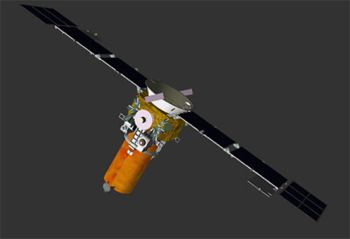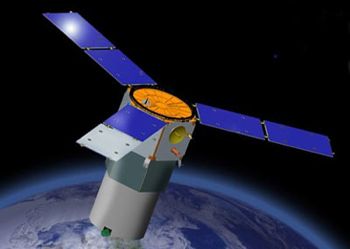
Home - Search - Browse - Alphabetic Index: 0- 1- 2- 3- 4- 5- 6- 7- 8- 9
A- B- C- D- E- F- G- H- I- J- K- L- M- N- O- P- Q- R- S- T- U- V- W- X- Y- Z
Tacsat ORS
 Tacsat-2 Credit: Manufacturer Image |
AKA: ORS. Status: Operational 2006. First Launch: 2006-12-16. Last Launch: 2011-09-27. Number: 4 . Gross mass: 370 kg (810 lb).
Objectives were to take the spacecraft from concept to launch under 14 months; to achieve full on-orbit functionality within a week after launch; to demonstrate communication, command and control of the satellite by tactical field units; to image targets on earth with a resolution of under 1 m; to geolocate emitting radio targets and image them in the same pass; and demonstrate several further advanced technology experiments. The prototypes were to lead to a production TacSat design that would give Joint Task Force Commanders a direct operational capability by 2010.
The spacecraft bus was developed by MicroSat Systems of Littleton, Colorado using the spare bus of the canceled TechSat-21 program. The bus structure consisted of composite face sheets over an aluminum honeycomb core, comprising only 13% of the spacecraft mass. The basic structure was an irregular octagon with a payload and a separation deck. The platform was 3-axis stabilized, capable of providing a pointing accuracy of = 0.15º. The ADCS (Attitude Determination and Control Subsystem) employed 3 reaction wheels (Dynacon MW-1000) and 3 torque rods as actuators. A star camera, referred to as ISC (Interstellar Compass), provided high-precision attitude measurements. An IMU (Inertial Measurement Unit), analog sun sensors, and a magnetometer completed the ADCS sensor suite. Electric power of up to 550 W was provided by the solar array. The Li-Ion battery had a capacity of 30 Ah. The bus power system provided 28 V switched power. The C&DH (Command and Data Handling) subsystem employed a Power PC. Bus communication were provided by a Mini-SGLS (Miniature Space-to-Ground Link Subsystem), using 2 pairs of patch antennas for full spherical coverage and an encryption device. The spacecraft had a mass of about 370 kg.
The most important innovation of TacSat-2 was the use of a space-based CDL. Flying a CDL transponder required ground-breaking work in frequency allocations and communications security (COMSEC) approaches. Direct tasking and data dissemination were implemented using the SIPRNet (Secret Internet Protocol Routing Network) capabilities, a classified network of DoD. The SIPRNet system objectives were to integrate all space assets into the forces so that the Joint Task Force (JTF) Commander could call up assets by deciding the payload capability required, i.e., the area of interest, the area for direct downlink, and the date the assets must be operational.
Tacsat-2 flew the following sensor/experiment complement:
- ESI (Earth Surface Imager) developed by AFRL and SAIC (Science Applications International Corporation). ESI was the prime instrument of TacSat-2 (pushbroom imager). The objective was to provide high-resolution imagery at < 1 m GSD (Ground Sample Distance). The instrument featured a Pan band and 3 multispectral bands (red, green, and blue) in the visible range across a swath of 6144 pixels (5 km swath width). The optics subsystem employed a COTS telescope of 50 cm aperture by RC Optical Systems. The imager used a Fairchild Imaging CCD 583 TDI line scan array, sampling at approximately 9600 lines/s. The TDI (Time Delay Integration) process was essentially noise-free, allowing charge accumulation to take place over the number of TDI stages, and preserved the ground resolution capability of the very high rates that the TDI lines were "scanned" off the array.
- TIE (Target Indicator Experiment), provided by NRL. It consisted of a wideband sensor to gather radar, radio and handheld communication signals. The objective was to locate targets based on RF signatures and in conjunction with P-3 aircraft. TIE was an improved version of that flown on the TacSat-1 satellite. TIE used a total of 11 antennas. The TIE payload performed real-time signal geolocation and SEI (Specific Emitter Identification) services of radio frequency (RF) signals using space- and air-based collection platforms. It was also capable of collecting the AIS (Automated Identification System) signal now required on large ships for port safety and homeland defense. The TIE payload was also reprogrammable on orbit for acquiring new targets. The TIE package featured a commercial telescope of 50 cm aperture to take high-resolution imagery in the same pass.
- CDL (Common Data Link) was an AFRL experimental communication system. The objective was to use it in combination with a ground-based CDL terminals. This high-performance system permitted downlink data rates of up to 274 Mbit/s. DoD designated CDL as its standard for use in imagery and signals intelligence in 1991. This link consisted of a secure, jam-resistant uplink operating at 200 kbit/s and a down link that could operate at various data rates. CDL was currently also being used on UAVs (Unmanned Aerial Vehicle) including Global Hawk and Predator.
- ROPE (Roadrunner On-orbit Processing Experiment). This payload consisted of an array of FPGAs (Field Programmable Gate Array) designed to process imagery into standard military imaging formats. ROPE supported event processing to identify likely targets, and JPEG data compression for real-time data transmission to the ground segment.
- HET (Hall Effect Thruster), provided by AFRL at Edwards AFB, CA. This demonstration ion engine was based on the Busek Tandem Hall Thruster BHT-200-X3 (Busek Co. Inc., Natik, MA). HET featured an Isp of up to 1600 s, variable thrust levels, and variable power usage. The nominal 200 W thruster had an operating envelope ranging from 50 to 300 W. The thrust range was 4-17 mN with nominally 12.4 mN. The instrument had a mass of < 1 kg and a size of 100 mm diameter and a length of 105 mm. HET was used was to maintain orbit against drag. The BHT-200-X3 represented the first U.S.-designed and built HET to fly in space.
- IGOR (Integrated GPS On-orbit Receiver), developed by Broad Reach Engineering (BRE), Tempe, AZ. IGOR was of BlackJack heritage of JPL. The objective was to conduct ionospheric reflection and transmission experiments. In addition, IGOR provided the spacecraft with a precise navigation solution in support of high-precision imaging observations. The instrument had dimensions of 200 mm x 240 mm x 105 mm, a mass of 4.6 kg, and a power consumption of 23 W (peak). 9)
- ADS (Atmospheric Density Specifications). ADS consisted of two complementary experiments to characterize the neutral wind of the upper atmosphere.
- ACME (Anemometer Cross-track Measurement Experiment). ACME measured the cross-track component of the very rarefied atmosphere at the orbital altitude of 350 km; it required precise pointing knowledge to remove the spacecraft in-track velocity component from its measurement. ACME was being by the University of Texas at Dallas, TX.
- ADMS (Absolute Density Mass Spectrometer). ADMS measured the atomic mass of the prevailing species in the wind in the range from 1 to 50. ADMS was being developed at AFRL, Hanscom AFB, MA.
- MVIS (Miniaturized Vibration Isolation System). The objective of MVIS was to demonstrate damping of spacecraft jitter - in support of higher-quality observation measurements. MVIS consisted of a series of actuators placed at the imager telescope assembly center of gravity.
- ESA (Experimental Solar Array), an innovative, low-cost, and lightweight flexible Thin Film Photovoltaic solar array system developed by MSI.
- Autonomy, developed by ICS (Interface & Control Systems, Chapel Hill, NC). Autonomy consisted of two subsystems: OOCE (On-Orbit Checkout Experiment), and ATE (Autonomous Tasking Experiment). The OOCE featured an enabling technology for autonomously commissioning the spacecraft (checkout) during its first day of orbital life. ATE permitted non-expert users in the battlefield to send data requests to the spacecraft (example: "image a particular region in latitude and longitude") and to receive the response directly, if possible with regard to the current spacecraft location in orbit. ATE also served as long-term and short-term experiment scheduler for all the payloads.
More at: Tacsat ORS.
Family: Communications, Military surveillance sat, MX, Surveillance, Technology. Country: USA. Launch Vehicles: Minuteman, Minotaur, Minotaur 1, Minotaur IV-Plus. Launch Sites: Wallops Island, Wallops Island LA0B. Bibliography: 2, 13247, 13248, 13249, 13250.
 | Tacsat 3 Credit: Manufacturer Image |
 | Tacsat 4 Credit: Manufacturer Image |
2006 December 16 - . 12:00 GMT - . Launch Site: Wallops Island. Launch Complex: Wallops Island LA0B. LV Family: Minuteman. Launch Vehicle: Minotaur 1.
- Tacsat-2 - .
Mass: 370 kg (810 lb). Nation: USA.
Agency: USAF RL.
Manufacturer: MicroSats.
Program: Tacsat.
Class: Surveillance.
Type: Military surveillance satellite. Spacecraft Bus: Road Runner.
Spacecraft: Tacsat ORS.
Decay Date: 2011-02-05 . USAF Sat Cat: 29653 . COSPAR: 2006-058A. Apogee: 426 km (264 mi). Perigee: 410 km (250 mi). Inclination: 40.01 deg. Period: 92.93 min.
Tacsat-2 was a prototype rapid development/rapid deployment tactical military satellite that provided American Joint Task Force commanders direct control of a satellite providing both SIGINT and imagery with a resolution of better than 1-m. The known communications payload used an 8 GHz (X-band) downlink. This was the first orbital launch from Wallops Island since 1985. TacSat-2 was to have been launched by a Falcon-1 from Vandenberg into a sun-synchronous orbit. However, the failure of Falcon-1 on its long-delayed maiden in March 2006 caused AFRL to award a new launch contract for TacSat-2 and TacSat-3 to OSC in May 2006. The launch was achieved using OSC's Minotaur launch vehicle only seven months after contract award.
2009 May 19 - . 23:55 GMT - . Launch Site: Wallops Island. Launch Complex: Wallops Island LA0B. LV Family: Minuteman. Launch Vehicle: Minotaur 1.
- Tacsat 3 - . Mass: 400 kg (880 lb). Nation: USA. Agency: USAF. Program: Tacsat. Class: Technology. Type: Surveillance jtechnology satellite. Spacecraft Bus: Road Runner. Spacecraft: Tacsat ORS. Decay Date: 2012-04-30 . USAF Sat Cat: 35001 . COSPAR: 2009-028A. Apogee: 465 km (288 mi). Perigee: 433 km (269 mi). Inclination: 40.50 deg. Period: 93.60 min. USAF experimental imaging satellite..
2011 June 30 - . 03:09 GMT - . Launch Site: Wallops Island. Launch Complex: Wallops Island LA0B. LV Family: Minuteman. Launch Vehicle: Minotaur 1.
- USA 231 - .
Payload: ORS-1. Mass: 450 kg (990 lb). Nation: USA.
Class: Surveillance.
Type: Military surveillance satellite. Spacecraft Bus: Road Runner.
Spacecraft: Tacsat ORS.
Decay Date: 2018-03-12 . USAF Sat Cat: 37728 . COSPAR: 2011-029A. Apogee: 409 km (254 mi). Perigee: 396 km (246 mi). Inclination: 40.00 deg. Period: 92.60 min.
Prototype optical surveillance satellite developed under the USAF Operationally Responsive Space program. Derived from Tacsat 3. Objective is to deploy small satellites to support military operations on short notice, either to provide a surge capability or to replace malfunctioning or disabled primary assets.
2011 September 27 - . 15:49 GMT - . Launch Site: Kodiak. LV Family: Peacekeeper. Launch Vehicle: Minotaur IV-Plus.
- Tacsat 4 - .
Mass: 460 kg (1,010 lb). Nation: USA.
Program: Tacsat.
Class: Communications.
Type: Military communications satellite. Spacecraft Bus: Road Runner.
Spacecraft: Tacsat ORS.
USAF Sat Cat: 37818 . COSPAR: 2011-052A. Apogee: 12,010 km (7,460 mi). Perigee: 742 km (461 mi). Inclination: 63.60 deg. Period: 238.90 min.
Naval Research Laboratory UHF communications satellite, equipped with a 3.7-meter-diameter communications antenna to support military handheld satellite telephones. Launch used an uprated Minotaur IV with an ATK Star 48V motor replacing the Orion 38 upper stage.
Back to top of page
Home - Search - Browse - Alphabetic Index: 0- 1- 2- 3- 4- 5- 6- 7- 8- 9
A- B- C- D- E- F- G- H- I- J- K- L- M- N- O- P- Q- R- S- T- U- V- W- X- Y- Z
© 1997-2019 Mark Wade - Contact
© / Conditions for Use